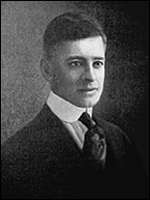About Maurice Meyer
 The Maurice Meyer Distinguished Endowed Lectureship brings noteworthy speakers to Rogers State University each fall to lecture on the topic of diversity and its role in a democracy. The lectureship was made possible by the late Irvin and Sharna Frank of Tulsa, who established the lectureship in honor of Sergeant Maurice Meyer, a brave Oklahoman who was killed in World War I. Sergeant Meyer was the uncle of Mr. Frank.
The Maurice Meyer Distinguished Endowed Lectureship brings noteworthy speakers to Rogers State University each fall to lecture on the topic of diversity and its role in a democracy. The lectureship was made possible by the late Irvin and Sharna Frank of Tulsa, who established the lectureship in honor of Sergeant Maurice Meyer, a brave Oklahoman who was killed in World War I. Sergeant Meyer was the uncle of Mr. Frank.
RSU’s Meyer Hall, which houses its main administrative offices and the Oklahoma Military Academy Museum, is named for Sergeant Meyer. The purpose of the endowed lectureship is to honor the life and legacy of Sergeant Meyer. In addition, the lectureship pays tribute to The Honorable Leo Meyer, father of Maurice Meyer, and former Secretary of State of Oklahoma (1907-1911) and State Auditor (1911-1913).
The lectureship strives to foster an appreciation of diversity and humanity and to promote tolerance and understanding of other cultures, people, and ideas. The lectureship series fosters an understanding of different cultures and helps students learn more about the impact of diversity in today’s global community.
Sergeant Meyer was a member of Company A, 357 Regiment. He served with distinction in the 90th Division during the St. Mihiel Campaign in France during World War I. Sergeant Meyer was mortally wounded by German shrapnel on September 23, 1918 during the St. Mihiel campaign. He died the following day.
Sergeant Meyer was accorded a hero’s funeral in Tulsa on May 3, 1922, widely believed to be the largest military funeral ever held in Tulsa. His body was borne on a gun carriage draped with an American flag through downtown Tulsa. Caissons from the Oklahoma Military Academy escorted the body to Temple Israel for the funeral.
The Oklahoma Military Academy was established on the RSU campus in 1919 by an act of the Oklahoma State Legislature. Under the leadership of Colonel S.M. Barrett, the first class of 40 high school cadets were enrolled in military and academy training at OMA in 1919. The cadets lived in tents and learned to “rough it” on the high ridge overlooking the city of Claremore. A year later, in 1920, the cadets moved into the newly completed barracks facility, named Maurice Meyer Barracks, which is now Meyer Hall.
Past Lecturers
- 2015: Judge Darnell Jones
- 2014: Ken Levit
- 2012: Rabbi Charles P. Sherman, D.D.
- 2011: The Rev. Dr. Mouzon Biggs, Jr.
- 2009: Ambassador James R. Jones
- 2007: Dr. Linda Zagzebski
- 2006: Dr. Stephen Prothero
- 2005: Dr. Roland Fryer, Jr.
- 2004: Wilma P. Mankiller
- 2003: Dr. Joshua M. Landis
- 2002: Chad “Corntassel” Smith, Principal Chief of the Cherokee Nation
- 2001: Dr. Jacob Howland, McFarlin Professor of Philosophy, University of Tulsa
- 2000: Rabbi Charles Philip Sherman, D.D.
